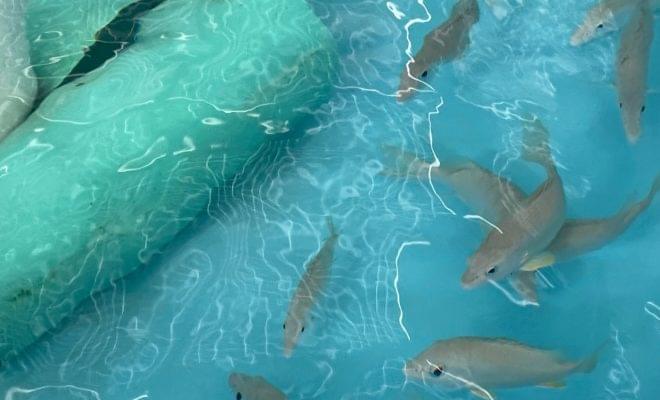Students in The Island School Semester participate in a research class, assisting our professional Research Staff with ongoing projects and data collection for a term. Each research class published a blog post to share their research alongside a final presentation and oral assessment. The post below was written by Asia Butler, Bede Levin, Charlotte Warner, Kelsey Ketchum, Lizzy Randall, Myles Change, and Roselym Reyes.
The Fall 2022 Semester was the first time Fish Physiology was integrated as a part of The Island School Semester research classes by the Gamperl Lab who arrived just before we did in late August. In the past 3 months we have learned about the internal and external anatomy of fish, fish locomotion, and how the surrounding environment affects their ability to perform day to day functions.

We assisted our advisor, Emma Porter, in performing surgery on schoolmaster snapper. She demonstrated how probes are put around their aorta to observe cardiac function when their environment changes; meaning when temperature is increased and/or when oxygen is reduced. We also dissected tilapia from the aquaponics system to examine their internal anatomy. Overall, we learned about the importance of fish welfare and husbandry and were taught how to properly clean the tanks to ensure optimal fish health.

We also learned how to set up and deploy fish traps in nearshore habitats and were taught the value of boat safety and navigation in remote coastal areas surrounding the Cape.

Our culminating project was based around the question “Are high temperatures associated with low levels of oxygen (hypoxia) in key Bahamian mangrove forests”? Ultimately, this baseline data is useful for better understand the impacts of climate change on this unique ecosystem, and specific to our interest, how it is impacting fish physiology. As a class we hypothesized that increases in temperatures throughout the day would be associated with extreme reductions in water oxygen content within these coastal marine habitats. This in turn could negatively affect the overall physiology of fish and the population dynamics of the whole ecosystem.

Throughout September and October, we went on various field expeditions to visit two different mangroves near The Island School: Page and Kemps Creek. There, we deployed MinDOT Clear temperature and oxygen loggers at 5 locations, from the mouth of the creek inward. These loggers allowed us to profile changes in water parameters over two 5-day periods in the late summer / early fall (October 6th to 22nd, 2022).

Once our data was fully analyzed (including statistic analysis), we were surprised to find that both temperature (in blue) and oxygen levels (in red) increased and decreased together. This trend was unexpected as most of the past research has associated elevated temperatures with drops in oxygen levels.
We discussed possible reasons as to why we had this outcome and came to a viable hypothesis: that the photosynthetic organisms, which likely exist in an abundance in these unique water systems, may provide a surplus of oxygen during peak UV. Interestingly, this spike in oxygen happens to coincide with the highest temperatures reached during the day, likely due to the shallow nature of these mangroves.

As climate change becomes a greater issue and water temperatures rise, fish will either be forced to adapt or will unfortunately face severe consequences. This is not only an ecological issue, but also poses a risk for economic sustainability (particularly for the local fishermen who may lose their source of income). Moving forward, greater funding needs to be allocated towards environmental monitoring programs that will help to determine the risk of climate change in The Bahamas. Our project, however, indicates that there may be a reprieve for the important fish species living in the mangroves in the Bahamas: that high oxygen levels (upwards of 150%) during peak temperatures (~ 33℃) may lessen the overall effects of climate change / high ocean temperatures. We are currently testing this hypotheses.
